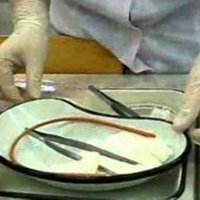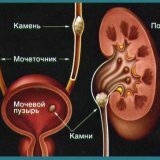Catheterization of the bladder

Catheterization is the procedure for inserting a catheter into the bladder cavity. It is designed to remove urine from the bladder for diagnostic and therapeutic purposes, as well as for washing the bladder. The procedure for catheterization requires special precautions not to infect the bladder. His mucous membrane weakly resists infection, which is why catheterization should be performed when absolutely necessary.
Introduction of a catheter to a woman
Before the procedure, a doctor( or nurse) washes his hands with soap, and rubs nail phalanx with alcohol and tincture of iodine. A woman is pre-sprinkled( if there are vaginal discharge) or washed away. The doctor stands to the right of the patient, lying on his back with legs, slightly dilated and half-bent at the knees. With the left hand, the large labia lips are extended with the right hand, and the external genitalia and the directly opening of the urethra with a special solution( usually a 1: 1000 solution of mercuric chloride, a solution of hydroxyanic mercury or furacilin) are carefully disinfected from the top to the bottom( toward the anus).Then a catheter is taken with forceps, dipped first into sterile vaseline oil, and carefully inserted into the opening of the urethra. When an urinary catheter emerges from the external opening, immersion is stopped.
When the urine ceases to flow independently, it is easy to press the area of the bladder through the abdominal wall to remove the remaining urine from it. In women, the urethra is short( up to 6 cm), so they have no great difficulty in catheterization. If you want to take the urine for planting, then the edges of the sterile test tube should be held over the flame, and then fill it with a sterile cotton plug after filling. In order to prevent ascending infection, it is very important to strictly follow all the rules.
Introduction of a catheter to a male
This procedure is much more difficult technically because the urethra in men is 25 cm long and has two physiological constrictions, which creates an obstacle for the passage of the catheter. During the catheterization the patient lies on his back with his legs bent at the knees and slightly diluted. Between the feet is placed a urine receiver, a mug or tray, where the urine will flow through the catheter. The doctor takes the penis with his left hand and carefully wipes his head and the hole of the urethra with cotton wool soaked in a solution of boric acid. Then, with the left hand, the sponges of the urethral opening are pushed apart, and the doctor inserts a soft catheter with a tweezers or a sterile gauze wipe with a little effort. It should be dipped preliminary into sterile petroleum jelly. Urine will appear as soon as the catheter hits the bladder. If an elastic catheter fails, a metal catheter is used. Such a catheter to men can be administered only by a qualified doctor.
Care of the urinary catheter
The presence of a permanent catheter in the bladder for the outflow of urine provides for a special hygienic care for it. It is also important that the patients comply with the established drinking regime. It is necessary to drink more often, reducing the concentration of urine and thus reducing the likelihood of infection within the urinary tract. Special hygiene measures include care of the perineum and the catheter itself.
It is important to observe the precautionary measures:
- thoroughly clean the crotch from front to back;
- ensure that the catheter is securely attached to the inner thigh area with a patch;
- attach the drainage bag to the bed so that it is below the level of the bladder but does not touch the floor;
- ensure that the catheter tube is not twisted;
For emptying the complete urinary drainage bag, you must:
- wear sterile gloves;
- place the measuring container under the discharge tube of the most drainage bag to measure the volume of urine;
- release the tube from the holder on the side of the drain bag, open the tube clamp;
- to drain the urine into a measuring container;
- close the clip, wipe the end of the branch pipe with an alcohol cloth, fix the branch pipe inside the holder;
- remove gloves and wash hands with soap.



